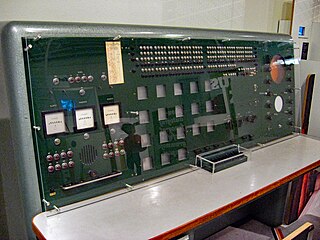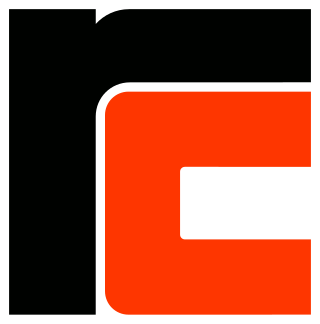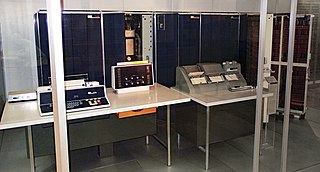
Trask or TRASK (TRAnsistorized Sequence Calculator) was a semiconductor based computer that begun development by the Swedish Board for Computing Machinery from 1960 and that went into use in 1965.

Trask or TRASK (TRAnsistorized Sequence Calculator) was a semiconductor based computer that begun development by the Swedish Board for Computing Machinery from 1960 and that went into use in 1965.
Swedish Board for Computing Machinery that had developed BESK began in 1960 the work to develop a new semiconductor based computer. The plan was to create a faster machine with the experiences from BESK as a foundation but built using semiconductors that since the invention of the transistor in 1947 had become useful for this purpose. When the Swedish Board for Computing Machinery were dissolved in 1963, the development were half ways and the project was overtaken by the Nobelinstitutet för fysik in cooperation with AB Datasystem, Gunnar Hellström and the designer Zoltan Horvath. TRASK went into service in 1965 and were used until 1980 when it was donated to the Swedish National Museum of Science and Technology where it were rebuilt and was put into operation for demonstrations.
TRASK is a fully transistorized mainframe intended for scientific calculations. It consists of central units in cabinets, two Facit ECM-64 carousel memories, Ampex memory unit (in a 19-inch rack, standing on top of the cabinets), paper tape readers, paper tape puncher, typewriter, maneuver panel and a desk.
Input- and output units were:

The PDP-1 is the first computer in Digital Equipment Corporation's PDP series and was first produced in 1959. It is famous for being the most important computer in the creation of hacker culture at the Massachusetts Institute of Technology, Bolt, Beranek and Newman and elsewhere. The PDP-1 is the original hardware for playing history's first game on a minicomputer, Steve Russell's Spacewar!

The IBM 1620 was announced by IBM on October 21, 1959, and marketed as an inexpensive scientific computer. After a total production of about two thousand machines, it was withdrawn on November 19, 1970. Modified versions of the 1620 were used as the CPU of the IBM 1710 and IBM 1720 Industrial Process Control Systems.

BESK was Sweden's first electronic computer, using vacuum tubes instead of relays. It was developed by Matematikmaskinnämnden and for a short time it was the fastest computer in the world. The computer was completed in 1953 and in use until 1966. The technology behind BESK was later continued with the transistorized FACIT EDB and FACIT EDB-3 machines, both software compatible with BESK. Non-compatible machines highly inspired by BESK were SMIL made for the University of Lund, SAABs räkneautomat SARA, "SAAB's calculating machine", and DASK made in Denmark.
The Cyclone is a vacuum-tube computer, built by Iowa State College at Ames, Iowa. The computer was commissioned in July 1959. It was based on the IAS architecture developed by John von Neumann. The Cyclone was based on ILLIAC, the University of Illinois Automatic Computer. The Cyclone used 40-bit words, used two 20-bit instructions per word, and each instruction had an eight-bit op-code and a 12-bit operand or address field. In general IAS-based computers were not code compatible with each other, although originally math routines which ran on the ILLIAC would also run on the Cyclone.

Regnecentralen (RC) was the first Danish computer company, founded on October 12, 1955. Through the 1950s and 1960s, they designed a series of computers, originally for their own use, and later to be sold commercially. Descendants of these systems sold well into the 1980s. They also developed a series of high-speed paper tape machines, and produced Data General Nova machines under license.

The Friden Flexowriter was a teleprinter produced by the Friden Calculating Machine Company. It was a heavy-duty electric typewriter capable of being driven not only by a human typing, but also automatically by several methods, including direct attachment to a computer and by use of paper tape.

A keypunch is a device for precisely punching holes into stiff paper cards at specific locations as determined by keys struck by a human operator. Other devices included here for that same function include the gang punch, the pantograph punch, and the stamp. The term was also used for similar machines used by humans to transcribe data onto punched tape media.
The APE(X)C, or All Purpose Electronic (X) Computer series was designed by Andrew Donald Booth at Birkbeck College, London in the early 1950s. His work on the APE(X)C series was sponsored by the British Rayon Research Association. Although the naming conventions are slightly unclear, it seems the first model belonged to the BRRA. According to Booth, the X stood for X-company.

The Bendix G-15 is a computer introduced in 1956 by the Bendix Corporation, Computer Division, Los Angeles, California. It is about 5 by 3 by 3 feet and weighs about 966 pounds (438 kg). The G-15 has a drum memory of 2,160 29-bit words, along with 20 words used for special purposes and rapid-access storage. The base system, without peripherals, cost $49,500. A working model cost around $60,000. It could also be rented for $1,485 per month. It was meant for scientific and industrial markets. The series was gradually discontinued when Control Data Corporation took over the Bendix computer division in 1963.

The LGP-30, standing for Librascope General Purpose and then Librascope General Precision, is an early off-the-shelf computer. It was manufactured by the Librascope company of Glendale, California, and sold and serviced by the Royal Precision Electronic Computer Company, a joint venture with the Royal McBee division of the Royal Typewriter Company. The LGP-30 was first manufactured in 1956, at a retail price of $47,000, equivalent to $530,000 in 2023.

IBM 7070 is a decimal-architecture intermediate data-processing system that was introduced by IBM in 1958. It was part of the IBM 700/7000 series, and was based on discrete transistors rather than the vacuum tubes of the 1950s. It was the company's first transistorized stored-program computer.

The NCR 315 Data Processing System, released in January 1962 by NCR, is a second-generation computer. All printed circuit boards use resistor–transistor logic (RTL) to create the various logic elements. It uses 12-bit slab memory structure using magnetic-core memory. The instructions can use a memory slab as either two 6-bit alphanumeric characters or as three 4-bit BCD digits. Basic memory is 5000 "slabs" of handmade core memory, which is expandable to a maximum of 40,000 slabs in four refrigerator-size cabinets. The main processor includes three cabinets and a console section that houses the power supply, keyboard, output writer, and a panel with lights that indicate the current status of the program counter, registers, arithmetic accumulator, and system errors. Input/Output is by direct parallel connections to each type of peripheral through a two-cable bundle with 1-inch-thick cables. Some devices like magnetic tape and the CRAM are daisy-chained to allow multiple drives to be connected.

The Elliott 803 is a small, medium-speed transistor digital computer which was manufactured by the British company Elliott Brothers in the 1960s. About 211 were built.
The Datamatic Division of Honeywell announced the H-800 electronic computer in 1958. The first installation occurred in 1960. A total of 89 units were delivered. The H-800 design was part of a family of 48-bit word, three-address instruction format computers that descended from the Datamatic 1000, which was a joint Honeywell and Raytheon project started in 1955. The 1800 and 1800-II were follow-on designs to the H-800.

The Elea was a series of mainframe computers Olivetti developed starting in the late 1950s. The system, made entirely with transistors for high performance, was conceived, designed and developed by a small group of researchers led by Mario Tchou (1924–1961), with industrial design by Ettore Sottsass. The ELEA 9001 was the first solid-state computer designed and manufactured in Italy. The acronym ELEA stood for Elaboratore Elettronico Aritmetico and was chosen with reference to the ancient Greek colony of Elea, home of the Eleatic school of philosophy. About forty units were placed with customers. In August 1964, only a few years after releasing the 9003, Olivetti's mainframe business was sold to GE.

The Monroe Calculating Machine Mark XI was a general-purpose stored-program electronic digital computer introduced in 1960 by the Monroe Calculating Machine Division of Litton Industries. The system was marketed for "primarily for billing, and invoice writing", but could also be used for low-end scientific computing.

The IBM 711 was a punched card reader used as a peripheral device for IBM mainframe vacuum tube computers and early transistorized computers. Announced on May 21, 1952, it was first shipped with the IBM 701. Later IBM computers that used it were the IBM 704, the IBM 709, and the transistorized IBM 7090 and 7094.

FACIT EDB was a computer based on vacuum tubes that was manufactured by Åtvidabergs Industrier AB after the designs for BESK, that had been developed by the Swedish Board for Computing Machinery (Matematikmaskinnämnden).
Philco was one of the pioneers of transistorized computers. After the company developed the surface barrier transistor, which was much faster than previous point-contact types, it was awarded contracts for military and government computers. Commercialized derivatives of some of these designs became successful business and scientific computers. The TRANSAC Model S-1000 was released as a scientific computer. The TRANSAC S-2000 mainframe computer system was first produced in 1958, and a family of compatible machines, with increasing performance, was released over the next several years.